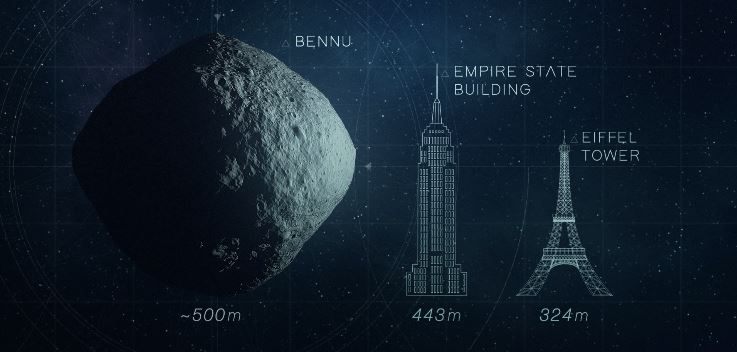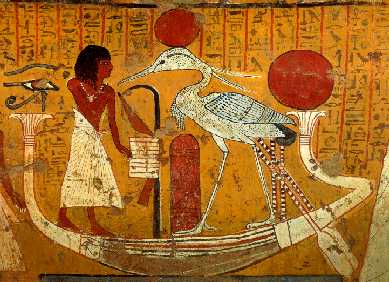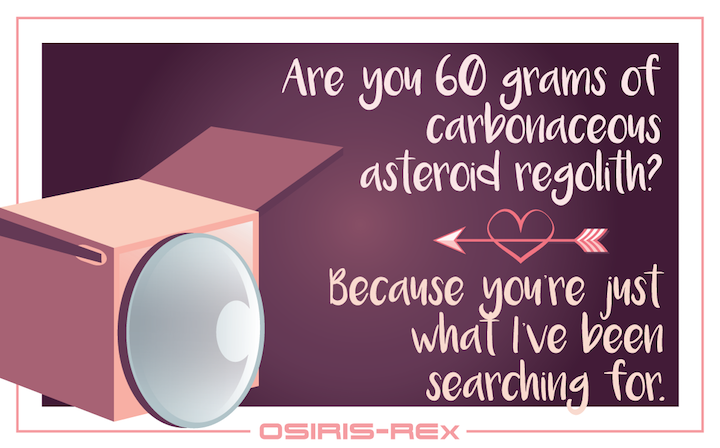
For the past two years, I have been following the voyage of OSIRIS-REx, a spacecraft headed to an asteroid called Bennu. Bennu is important for at least four reasons:
- Local space history may recorded in its rocks, which are about as old as the formation of the solar system.
- It is carbon-rich and scientists think it might have molecules similar to the precursors to life on Earth.
- It has goodies we might want to mine someday, like precious metals.
- “it has a relatively high probability of impacting the Earth late in the 22nd century.” So there’s that.
OSIRIS-REx’s mission: map the asteroid, collect samples, and then return home with the scientific booty. Also: determine whether Bennu is going to clobber us. We have enough time that we could figure out how to turn it aside.
OSIRIS-REx is cool because its name is a complex acronym that invokes both the Egyptian god of life and death and everyone’s favorite theropod. It is cool because the communications team issues goofy Valentines every February (“Where have you Bennu all my life?”). But mostly it is cool because unlike many other scientific space missions, it is coming back. Something about the “return” in “sample return mission” really thrills me. I stand in undying awe of the scientists, mathematicians, programmers, and engineers behind sending a craft smaller than a shipping container more than a billion miles to land on a rock with a diameter of 500 meters—and then bringing it home.
And this week OSIRIS-REx (which looks a bit like a flying toaster) finally saw Bennu! You can see the video here. Yes, the asteroid looks like a jerkily moving bit of TV static, but this is incredibly exciting. As the first YouTube commenter put it, “The hype is real.”
OSIRIS-REx is scheduled to arrive at Bennu on December 3rd and start collecting data. It’ll begin by orbiting the asteroid. Fun fact: Bennu will the smallest body that any human spacecraft has ever orbited. The gravity will be super low. Landing will have to wait for 2020, and then once OSIRIS-REx has its pockets full of rocks and dust–what scientists in the know call “regolith”–it’ll head back home. The plan is that it will eject a capsule full of samples into the Utah desert in September 2023. The contents will no doubt be studied by scientists for generations. I can’t wait.
Looking at that little fleck of white on the video, I feel pretty excited. Bennu is little snow globe capturing the geochemistry of the early solar system. It is a beautiful, mysterious deeply dark object, shaped like a big space egg. That egg shape is part of why it is called Bennu, which is apparently the name of another Egyptian god, this one in the form of a heron and involved, appropriately, in the creation of the world. Bennu may have inspired the myth of the Phoenix, a bird who emerges alive from the ashes after being burned.

Bennu was named by a kid in a contest. I love these kinds of contests and the kids who win them (Did you know that the Alaska flag, which is probably the best state flag, was designed by a 13-year old Alutiiq kid named Benny Benson?) The kid who named Bennu in 2013, nine-year-old Michael Puzio, was quoted at the time as saying “It’s great! I’m the first kid I know that named part of the solar system!”
So tonight as you drift off to sleep, think about the little space toaster a billion years from Earth taking a good long look at a 4.5-billion-year-old asteroid named by a nine-year-old kid after a 3,500-year-old uncreated bird god.
Or, in the words of one of the mission’s Valentines:
